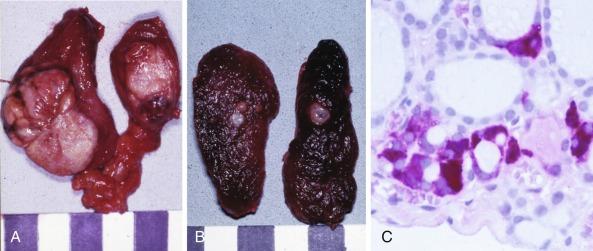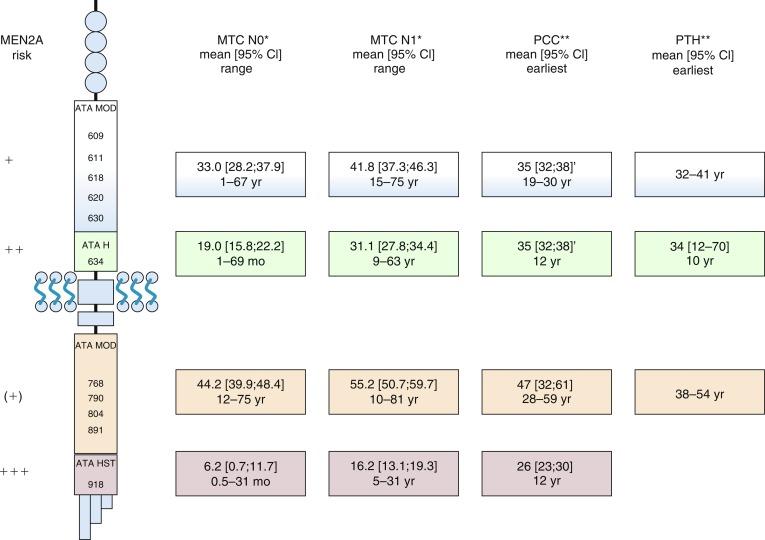Physical Address
304 North Cardinal St.
Dorchester Center, MA 02124
As early as the beginning of the 20th century, medullary thyroid carcinoma (MTC) was noted as a distinct disease entity within the broad spectrum of malignant thyroid tumors. By the first half of the century, the peculiar tumor biology of the sporadic type had been described as “small tumors with early lymphatic and hematogenous spread,” whereas multicentric MTC had become the hallmark of familial tumors. Probably the first report of multiple endocrine neoplasia (MEN) 2B regarded a 12-year-old boy presented by Walther Burk in 1901. Yet it was E.D. Williams who clearly defined syndromic MTC as a separate entity in 1965 by publishing the first comprehensive series of hereditary pheochromocytoma (PCC) associated with MTC. The 1993 detection of the susceptibility gene of hereditary MTC by Mulligan et al. and Donis-Keller et al. ushered in the era of genotype-phenotype oriented prophylactic surgery ( Figure 27.1 ), completing a 100-year evolutionary saga of clinical, biochemical, and molecular discoveries (see Figure 27.1 ). Hereditary MTC, unique in many ways among hereditable cancer syndromes, is founded on the following findings:
The hereditary variant, affecting as many as 25% of MTC patients, is more frequent than many other common hereditary tumors.
Unlike many other hereditary tumors, hereditary MTC features a strong genotype-phenotype correlation that is utilized worldwide for risk assessment. This genotype-dependent, age-related tumor progression not only underlies the development of hereditary MTC but also the formation of MEN 2–associated PCC and hyperparathyroidism (HPT).
Disease progression from C-cell hyperplasia to MTC, requiring the acquisition of somatic mutations for malignant progression, is a stochastic sequence of events not fully under the control of a gene carrier’s genetic makeup. Serum calcitonin, a sensitive diagnostic marker of MTC, better reflects a gene carrier’s stage of C-cell disease than his or her underlying germline mutation in the RET ( RE arranged during T ransfection) proto-oncogene. We may now tailor the timing and extent of surgical intervention in the neck to the gene carrier’s stage of disease through consideration of serum calcitonin levels.
Lymph node metastases are indicative of progressive disease, portending a worse prognosis for sporadic and hereditary MTC alike. Although multifocal tumor growth is more common in hereditary than in sporadic MTC (65% versus 8%, respectively), no difference in biochemical cure and survival between hereditary and sporadic disease has been found after adjusting for extent of disease.
MEN 2B is a special and virulent variant of MEN type 2 characterized by the presence of MTC in early infancy. More than 90% of MEN 2B RET gene carriers harbor de novo germline mutations. Such de novo germline mutations are rare in other MTC syndromic settings such as familial MTC (FMTC) and MEN 2A. Therefore indiscriminate DNA-based screening of infants and children for the MEN 2B trait is rarely an option. Intriguingly, there are some early clues in MEN 2B infants, notably “tearless crying” and “pseudo-Hirschsprung’s disease.” These clinical signs may help identify gene carriers before they develop the more characteristic MEN 2B stigmata, prompting rapid DNA-based screening and immediate surgical intervention.

Activating germline mutations in the RET proto-oncogene on chromosome 10q11.2, which cluster in “hot spot” regions, by definition involve all cells of the body (also termed the first hit in Knudson’s model of oncogenesis). These germline mutations do not equally affect all neuroendocrine and nonendocrine tissues, and many tissues may not be affected at all. The appearance of the various syndromic components is largely age-dependent and characterized by a great deal of variability, especially among those gene carriers whose germline mutations have the weakest transforming activity. Different tissue-specific susceptibilities are considered the main driver behind FMTC/MEN 2A/MEN 2B phenotypes, all of which share MTC as an integral element.
Originally defined as an entity in its own right based on a minimum of four affected kindreds, FMTC is now conceived as an abortive form of MEN 2, which becomes manifest with the subsequent development of PCC or HPT. Such a conversion from an FMTC-only to a MEN 2 phenotype during the patient’s lifetime is the rule rather than the exception for RET germline mutations in highest (‘HST’)-risk codon 918 (American Thyroid Association [ATA] category HST) and high (‘H’)-risk codon 634 (ATA category H), common for mutations in moderate(‘MOD’)- to high-risk codons 620 and 618, and to a lesser extent for those in codons 611 and 609 (ATA category MOD), and rare for mutations in low- to moderate-risk codons 768, 790, 804, and 891 (ATA category MOD). Some 6.5% to 9.5% of patients with seemingly sporadic MTC may harbor RET germline mutations. These gene carriers cannot be recognized unless all relevant exons of the gene have been screened.
MEN 2 comprises some or all of the following parts: (1) neuroendocrine components: MTC (unifocal or multifocal, unilateral or bilateral), PCC (unifocal or multifocal, unilateral or bilateral), or HPT (pseudonodular hyperplasia of one or more parathyroid glands), and (2) nonendocrine components: Hirschsprung’s (HSCR) disease and cutaneous lichen amyloidosis (CLA; typically MEN 2A).
The RET germline mutations underlying MEN 2A ( Figure 27.2 ) mainly involve high-risk codon 634 (ATA category H) as the classic “MEN 2A codon,” infrequently involve moderate- to high-risk codons 620, 618, and to a lesser degree codons 611 and 609 (ATA category MOD), and rarely low- to moderate-risk codons 768, 790, 804, or 891 (ATA category MOD).

Representing the usual first component of the MEN 2 syndrome, MTC is the only element common to FMTC, MEN 2A, and MEN 2B phenotypes. RET germline mutations are believed to drive C-cell hyperplasia, which can evolve to frank MTC with the acquisition of additional somatic mutations (“second hits”) in RET or other genes. Annual primary tumor growth is estimated at 0.4 to 0.5 mm in node-negative RET carriers, and at 1.2 mm (with low- to moderate-risk mutations) and 2.6 mm (with high-risk mutations) in node-positive carriers. C-cell hyperplasia often is multifocal, involving both thyroid lobes, especially in carriers of the stronger germline mutations in highest-risk codon 918 (ATA category HST) and high-risk codon 634 (ATA category H). Because it takes time to acquire those somatic mutations necessary for malignant transformation, the development of MTC is age-dependent and varies by affected RET codon (see Figure 27.2 ): highest-risk mutations (ATA category HST) by the time of birth, high-risk mutations (ATA category H) as early as age 1 year, moderate- to high-risk mutations (ATA category MOD) as early as age 5 years, and low- to moderate-risk mutations (ATA category MOD) as early as age 10 years.
Owing to the lower susceptibility of adrenal medullary relative to thyroidal C-cells, PCC represents the second most frequent syndromic manifestation. Among carriers with PCC, MTC and PCC coexist at the time of diagnosis in 60% with highest-risk mutations in codon 918 (ATA category HST) and in 35% with high-risk mutations in codon 634 mutations (ATA category H). Only rarely is PCC the initial MEN 2 component among carriers with PCC: 0% with highest-risk mutations in codon 918 (ATA category HST), 35% with high-risk mutations in codon 634 (ATA category H), and 4% with moderate- to high-risk mutations (ATA category MOD). Adrenal ganglioneuroma perhaps represents another, though unusual, component of the MEN 2A and 2B syndromes. Because systematic RET gene analysis and family screening deplete the pool of unrecognized index patients in the population, PCC is less likely to present before, or together with, MTC in the future.
Activating RET germline mutations are also thought to give rise to adrenal medullary hyperplasia from which PCC may develop upon allelic loss at chromosome 1p or deletion of the von Hippel-Lindau gene. This process varies by affected codon (see Figure 27.2 ): in highest- and high-risk mutations (ATA categories HST and H) as early as ages 8 to 10 years and in moderate-risk mutations (ATA category MOD) as early as age 20 years.
Parathyroid chief cells seem to be less responsive to RET activation as parafollicular C-cells of the thyroid or adrenal medullary cells. For unknown reasons, HPT, which is generally mild, is not an integral part of the MEN 2B syndrome. Although HPT is fairly common (19.1% prevalence) among carriers of high-risk mutations in codon 634 (ATA category H), it is infrequent among carriers of moderate-risk mutations in codons 620, 618, 611, 609, and 768, 790, 804, and 891 (ATA category MOD). The development of HPT is age-dependent, due to the need to acquire “second hits” and varies by mutational risk category (see Figure 27.2 ): for high-risk mutations (ATA category H), the respective mean and minimum manifestation age is 34 years and 10 years, and for moderate-risk mutations age of manifestation ranges from 32 to 41 years (moderate- to high-risk mutations) and from 38 to 54 years (low- to moderate-risk mutations).
Some 6% to 16% of RET families with moderate- to high-risk germline mutations (ATA category MOD) in exon 10 (codons 620 and 618, and more rarely 611 and 609) develop a peculiar phenotype consisting of both a “gain of function” FMTC/MEN 2A phenotype and a “loss of function” HSCR phenotype. These genotypes have been dubbed “Janus genes,” referring to the Roman god of doorways facing either way. Frequently, HSCR disease precedes the clinical manifestation of MTC and PCC. The “loss of function” HSCR phenotype is thought to be due to the trapping of precursor RET receptor proteins in the endoplasmatic reticulum, precluding their transport to the cell membrane. Decreased cell surface concentrations of RET receptor proteins are believed to cause the premature arrest of the craniocaudal migration of enteric neurons during the 5th to 12th week of gestation. The absence of autonomic ganglion cells (aganglionosis) within parasympathetic submucosal and myenteric plexuses causes the HSCR symptoms of functional obstruction and megacolon. In stark contrast, gastrointestinal ganglioneuromatosis, also dubbed “pseudo-Hirschsprung’s disease,” which is a feature of MEN 2B (codon 918), is characterized by the presence of ganglioneuromas in these plexuses.
This condition may occur in as many as 9% of MEN 2A families. It is almost always associated with RET germline mutations in codon 634, with one reported kindred each carrying a RET germline mutation in codon 804 or codon 891. Itching is usually the first manifestation of CLA. It is typically located in the upper back at either or both interscapular regions in an area of repeated scratching, involving the dermatomes between C4 and T5. The neural crest cells, implicated in the embryonic development of the parafollicular C-cells and adrenal medulla, are also involved in the embryogenesis of the thoracic sensory fibers. These dermatologic symptoms often precede the clinical manifestation of MTC, yet the evolution of CLA is independent of the course of the disease and unrelated to the development of PCC or HPT.
Become a Clinical Tree membership for Full access and enjoy Unlimited articles
If you are a member. Log in here